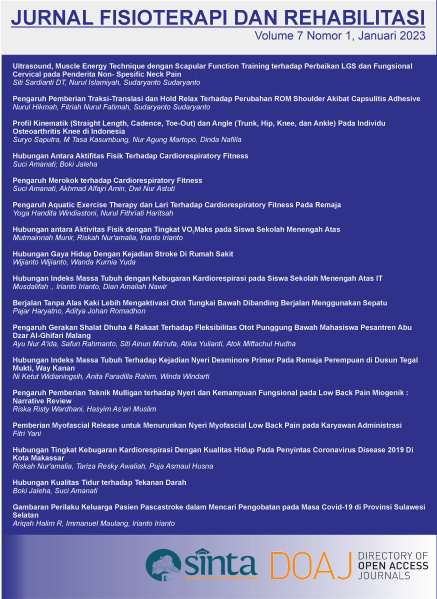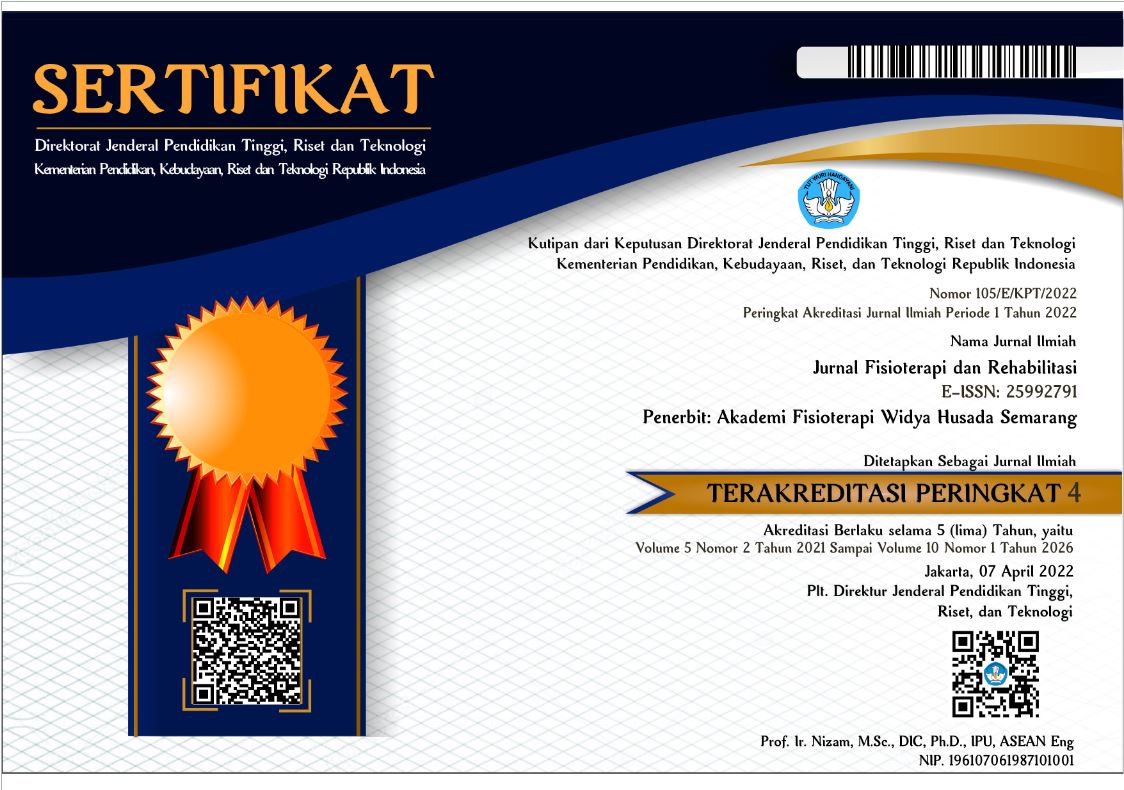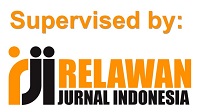Pemberian Myofascial Release untuk Menurunkan Nyeri Myofascial Low Back Pain pada Karyawan Administrasi
Myofascial Release In Relieving Myofascial Low Back pain in Administration Worker
Abstract
Nyeri Myofascial adalah masalah nyeri musculoskeletal yang umum, dengan nyeri myofascial punggung bagian bawah (myofascial low back pain) menjadi salah satu daerah yang paling sering terkena. Myofascial release merupakan intervensi yang banyak digunakan untuk mengurangi nyeri myofascial. Penelitian ini bertujuan membuktikan myofascial release dapat menurunkan nyeri myofascial punggung bagian bawah (myofascial low back pain). Penelitian menggunakan desain experimental dengan pre-test dan post test one grup yang berisikan 10 sampel dengan dosis intervensi diberikan selama 4 minggu dengan 3 kali dalam seminggu. Pengukuran nyeri menggunakan Visual analogue scale dan dengan cara mengukur nyeri sebelum dan sesudah intervensi. Sampel dengan kriteria inklusi positif nyeri myofascial low back pain dan kriteria eksklusi diantaranya subjek memiliki kelainan fraktur clavicula atau vertebra. Terjadi penurunan nyeri pada sampel yang berarti menunjukkan myofascial release dapat menurunkan nyeri secara bermakna.
Downloads
References
Andini, F. (2015) ‘Risk Factors of Low Back Pain in Workers’, Medical Journal of Lampung University, 4(1), pp. 12–17.
Anggraeni, N. C. (2014) ‘Penerapan Myofascial Release Technique Sama Baik Dengan Ischemic Compression Technique Dalam Menurunkan Nyeri Pada Sindroma Miofasial Otot Upper Trapezius’, Majalah Ilmiah Fisioterapi Indonesia, 2(2), pp. 1–12. Available at: https://doi.org/10.24843/MIFI.2014.v02.i02.p04%0Ahttps://ojs.unud.ac.id/index.php/mifi/article/download/8437/6295/.
Bhalara, A. dan Shah, S. (2012) ‘Myofascial Release’, Internasional Journal of Health Sciences & Research, 2(2).
Haikal, M. and Wijaya, S. M. (2018) ‘Risiko Low Back Pain (LBP) pada Pekerja dengan Paparan Whole Body Vibration (WBV)’, J Agromedicine, 5(1), pp. 529–533.
Mehrdad, R. et al. (2016) ‘Prevalence of low back pain in health care workers and comparison with other occupational categories in Iran: A systematic review’, Iranian Journal of Medical Sciences, 41(6), pp. 467–478.
Meucci, R. D., Fassa, A. G. and Xavier Faria, N. M. (2015) ‘Prevalence of chronic low back pain: Systematic review’, Revista de Saude Publica, 49, pp. 1–10. doi: 10.1590/S0034-8910.2015049005874.
Novitasari, D. D. et al. (2016) ‘Prevalence and Characteristics of Low Back Pain among Productive Age Population in Jatinangor’, pp. 469–476.
Panjabi, M. M. (2013) ‘The stabilizing system of the spine. Part II. neutral zone and instability hypothesis’, Journal of Spinal Disorders, 5(4), pp. 390–397. doi: 10.1097/00002517-199212000-00002.
Pramita, I., Pangkahila, A. and Sugijanto, S. (2015) ‘Core Stability Exercise Lebih Baik Meningkatkan Aktivitas Fungsional daripada William’s Flexion Exercise pada Pasien Nyeri Punggung Bawah Miogenik’, Sport and Fitness Journal, 3(1), pp. 35–49.
Ramsook, R. R. and Malanga, G. A. (2012) ‘Myofascial low back pain’, Current Pain and Headache Reports, 16(5), pp. 423–432. doi: 10.1007/s11916-012-0290-y.
Sharan, D. et al. (2014) ‘Myofascial Low Back Pain Treatment’, Current Pain and Headache Reports, 18(9). doi: 10.1007/s11916-014-0449-9.
Takei, H. (2012) ‘Myofascial release’, Rigakuryoho Kagaku, 16(2), pp. 103–107. doi: 10.1589/rika.16.103.
Wilke, J., Vogt, L. and Banzer, W. (2015) ‘Immediate Effects of Self-myofascial Release on Latent Trigger Point Sensitivity’, Biol Sport, 35(4), pp. 349–354. Available at: https://www.cochranelibrary.com/central/doi/10.1002/central/CN-01553839/full.
Wu, A. et al. (2020) ‘Global low back pain prevalence and years lived with disability from 1990 to 2017: estimates from the Global Burden of Disease Study 2017’, Annals of Translational Medicine, 8(6), pp. 299–299. doi: 10.21037/atm.2020.02.175.

This work is licensed under a Creative Commons Attribution 4.0 International License.
The use of the article will be governed by the Creative Commons Attribution license as currently displayed on Creative Commons Attribution 4.0 International License.
Author’s Warranties
The author warrants that the article is original, written by stated author(s), has not been published before, contains no unlawful statements, does not infringe the rights of others, is subject to copyright that is vested exclusively in the author and free of any third party rights, and that any necessary written permissions to quote from other sources have been obtained by the author(s).
User Rights
JFR's spirit is to disseminate articles published are as free as possible. Under the Creative Commons license, JFR permits users to copy, distribute, display, and perform the work. Users will also need to attribute authors and JFR on distributing works in the journal.
Rights of Authors
Authors retain all their rights to the published works, such as (but not limited to) the following rights;
- Copyright and other proprietary rights relating to the article, such as patent rights,
- The right to use the substance of the article in own future works, including lectures and books,
- The right to reproduce the article for own purposes,
- The right to self-archive the article
Co-Authorship
If the article was jointly prepared by other authors, any authors submitting the manuscript warrants that he/she has been authorized by all co-authors to be agreed on this copyright and license notice (agreement) on their behalf, and agrees to inform his/her co-authors of the terms of this policy. JFR will not be held liable for anything that may arise due to the author(s) internal dispute. JFR will only communicate with the corresponding author.
Miscellaneous
JFR will publish the article (or have it published) in the journal if the article’s editorial process is successfully completed. JFR's editors may modify the article to a style of punctuation, spelling, capitalization, referencing and usage that deems appropriate. The author acknowledges that the article may be published so that it will be publicly accessible and such access will be free of charge for the readers as mentioned in point 3.












